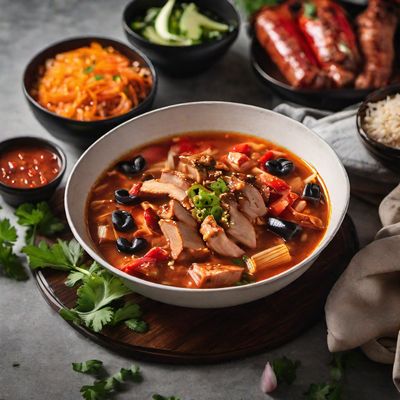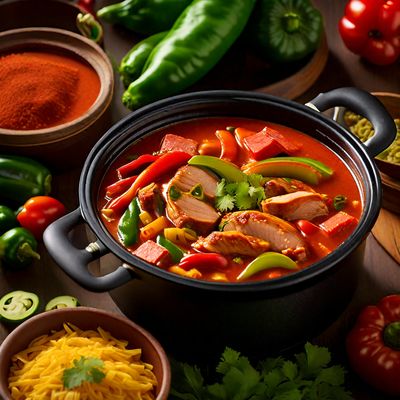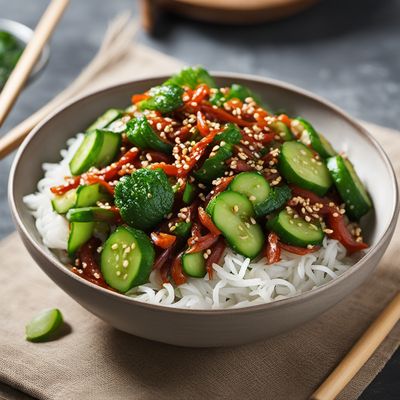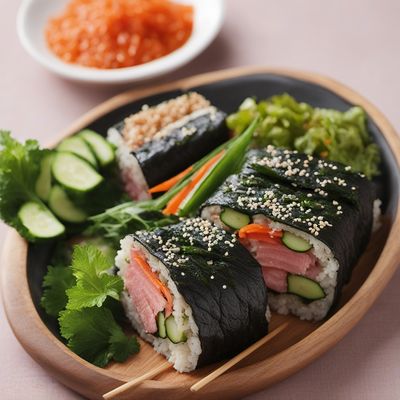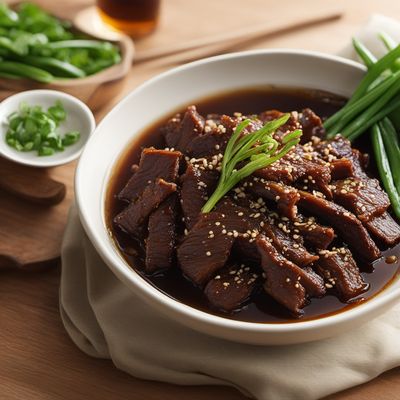
Recipe
Vietnamese-style Budae Jjigae
Vietnamese-inspired Spicy Army Stew
4.9 out of 5
In Vietnamese cuisine, bold flavors and fresh ingredients are key. This Vietnamese-style Budae Jjigae takes inspiration from the Korean classic and infuses it with the vibrant and aromatic elements of Vietnamese cooking. The result is a spicy and hearty army stew that combines the best of both worlds.
Metadata
Preparation time
20 minutes
Cooking time
20 minutes
Total time
40 minutes
Yields
4 servings
Preparation difficulty
Medium
Suitable for
Pescatarian, Dairy-free, Gluten-free, Nut-free, Low-carb
Allergens
Shellfish (shrimp), Soy (soy sauce)
Not suitable for
Vegan, Vegetarian, Paleo, Keto, High-carb
Ingredients
While the original Korean Budae Jjigae is known for its fusion of Korean and American flavors, this Vietnamese adaptation incorporates traditional Vietnamese ingredients and flavors. The use of aromatic herbs, spices, and fresh vegetables gives this dish a distinct Vietnamese twist, making it a unique and flavorful experience. We alse have the original recipe for Budae jjigae, so you can check it out.
-
200g (7 oz) thinly sliced pork belly 200g (7 oz) thinly sliced pork belly
-
200g (7 oz) boneless, skinless chicken thighs, cut into bite-sized pieces 200g (7 oz) boneless, skinless chicken thighs, cut into bite-sized pieces
-
200g (7 oz) Vietnamese sausage, sliced 200g (7 oz) Vietnamese sausage, sliced
-
200g (7 oz) shrimp, peeled and deveined 200g (7 oz) shrimp, peeled and deveined
-
200g (7 oz) firm tofu, cut into cubes 200g (7 oz) firm tofu, cut into cubes
-
100g (3.5 oz) enoki mushrooms 100g (3.5 oz) enoki mushrooms
-
100g (3.5 oz) shiitake mushrooms, sliced 100g (3.5 oz) shiitake mushrooms, sliced
-
1 small onion, thinly sliced 1 small onion, thinly sliced
-
2 cloves garlic, minced 2 cloves garlic, minced
-
2 green onions, chopped 2 green onions, chopped
-
2 tablespoons vegetable oil 2 tablespoons vegetable oil
-
2 tablespoons gochujang (Korean red pepper paste) 2 tablespoons gochujang (Korean red pepper paste)
-
1 tablespoon fish sauce 1 tablespoon fish sauce
-
1 tablespoon soy sauce 1 tablespoon soy sauce
-
1 tablespoon sugar 1 tablespoon sugar
-
1 teaspoon sesame oil 1 teaspoon sesame oil
-
4 cups (950ml) chicken broth 4 cups (950ml) chicken broth
-
2 cups (470ml) water 2 cups (470ml) water
-
Salt and pepper to taste Salt and pepper to taste
Nutrition
- Calories (kcal / KJ): 450 kcal / 1884 KJ
- Fat (total, saturated): 25g, 7g
- Carbohydrates (total, sugars): 15g, 5g
- Protein: 40g
- Fiber: 3g
- Salt: 2g
Preparation
-
1.Heat vegetable oil in a large pot over medium heat. Add minced garlic and sliced onion, and sauté until fragrant.
-
2.Add pork belly and chicken thighs to the pot, and cook until browned.
-
3.Stir in gochujang, fish sauce, soy sauce, and sugar. Mix well to coat the meat.
-
4.Add chicken broth and water to the pot, and bring to a boil.
-
5.Reduce heat to low, and simmer for 10 minutes to allow the flavors to meld.
-
6.Add Vietnamese sausage, shrimp, tofu, enoki mushrooms, and shiitake mushrooms to the pot. Cook for an additional 5 minutes, or until the shrimp is cooked through.
-
7.Season with salt and pepper to taste. Stir in chopped green onions and sesame oil.
-
8.Serve hot with steamed rice.
Treat your ingredients with care...
- Pork belly — For a leaner option, you can substitute pork loin or chicken breast.
- Vietnamese sausage — If you can't find Vietnamese sausage, you can use Chinese sausage or chorizo as a substitute.
- Gochujang — Adjust the amount of gochujang according to your spice preference. Add more for extra heat or reduce for a milder flavor.
- Fish sauce — If you prefer a vegetarian version, you can substitute soy sauce or tamari.
- Enoki mushrooms — Trim the tough ends of the enoki mushrooms before adding them to the stew.
Tips & Tricks
- To enhance the flavor, you can add a few slices of lemongrass and a handful of Thai basil leaves to the stew.
- If you prefer a thicker broth, you can dissolve 1 tablespoon of cornstarch in water and add it to the stew during the last few minutes of cooking.
- Customize the vegetables according to your preference. You can add bok choy, bean sprouts, or sliced bell peppers for extra crunch and freshness.
- Leftovers can be stored in the refrigerator for up to 3 days. The flavors will continue to develop, making it even more delicious the next day.
- This stew is traditionally served family-style, so gather your loved ones around the table and enjoy it together.
Serving advice
Serve the Vietnamese-style Budae Jjigae hot in individual bowls, accompanied by steamed rice. Garnish with fresh herbs like cilantro or Thai basil for an extra burst of flavor. Provide chopsticks and spoons for easy eating.
Presentation advice
To make the dish visually appealing, arrange the ingredients in the stew neatly and garnish with a sprinkle of chopped green onions and a drizzle of sesame oil. Serve it in a colorful ceramic bowl to enhance the presentation.
More recipes...
For Budae jjigae » Browse all
For Korean cuisine » Browse all
More Korean cuisine dishes » Browse all
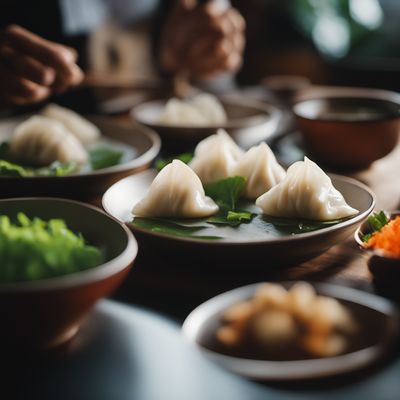
Mandu
Mandu is a traditional Korean dish that is similar to Chinese dumplings. It is typically filled with pork, beef, or vegetables, and is served...
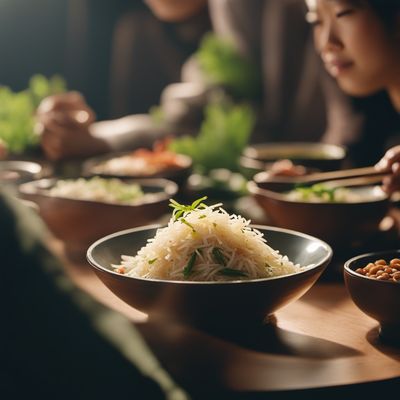
Kongnamulbap
Bean Sprout Rice
Kongnamulbap is a popular Korean dish that is made with rice and soybean sprouts. It is a flavorful and healthy dish that is perfect for any occasion.

Chamchi gimbap
Tuna gimbap
Chamchi gimbap is a type of Korean sushi that is filled with tuna. It is a popular snack that is easy to eat on the go.
More Vietnamese cuisine dishes » Browse all

Bánh gai
Banh gai
Bánh gai is a traditional Vietnamese dessert that is made with sticky rice and pandan leaves. It is a sweet and fragrant dessert that is perfect...

Bánh khọt
Banh Khot
Bánh khọt is a Vietnamese savory mini pancake made from rice flour and coconut milk, typically topped with shrimp, scallions, and mung bean.
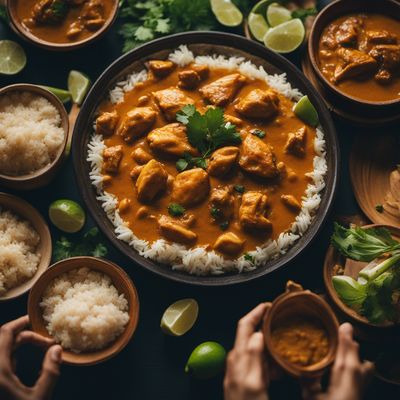
Cà ri gà
Chicken curry
Cà ri gà is a traditional Vietnamese curry that is made with chicken and a variety of vegetables. It is a rich and flavorful dish that is perfect...
